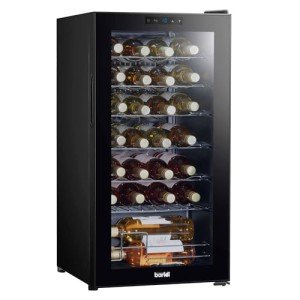Understanding Fridges and Freezers: The Essential Kitchen Appliances
Refrigerators and freezers are two of the most important appliances in modern-day cooking areas. These home appliances serve an essential role in food conservation and waste reduction by ensuring that disposable items remain fresh and safe for consumption. This short article digs into the various kinds of fridges and freezers, their functionalities, and crucial considerations for choice and maintenance.
Types of Refrigerators
The market uses a variety of refrigerator types, each developed to satisfy different consumer needs. Below is a list of the most typical kinds of fridges:
Top-Freezer Refrigerators
- Most common type.
- Freezer compartment is situated above the refrigerator area.
- Typically more inexpensive and energy-efficient.
Bottom-Freezer Refrigerators
- Freezer is located at the bottom.
- Enables easier access to fresh items at eye level.
- Typically includes pull-out drawers for much better company.
Side-by-Side Refrigerators
- Refrigerator and freezer sections are adjacent.
- Ideal for narrow cooking areas and enables simple access to both compartments.
- Typically includes water and ice dispensers.
French Door Refrigerators
- Integrates a bottom freezer with double doors at the top.
- Deals sufficient storage and elegant styles.
- Often consists of functions like temperature-controlled drawers.
Compact Refrigerators
- Smaller sized size suitable for limited spaces.
- Commonly utilized in dorm rooms, little apartments, or as secondary fridges.
Table 1: Comparison of Refrigerator Types
| Type | Advantages | Disadvantages | Normal Size |
|---|---|---|---|
| Top-Freezer | Budget friendly, energy-efficient | Less hassle-free access to the freezer | 14-30 cu. ft. |
| Bottom-Freezer | Much easier access to fresh food | Freezer can be harder to arrange | 19-30 cu. ft. |
| Side-by-Side | Easy access, water/ice dispenser | Narrow vs. storage space | 22-30 cu. ft. |
| French Door | Stylish, roomy, organized | More expensive | 20-30+ cu. ft. |
| Compact | Space-saving, portable | Restricted storage | 1.7-5.5 cu. ft. |
Types of Freezers
Freezers are an equally crucial appliance for food conservation. They come in various styles designed to fit different household needs. Consider the list below types:
Upright Freezers
- Run like a basic refrigerator with vertical storage.
- Much easier to arrange with racks and compartments.
Chest Freezers
- Large, horizontal design typically providing more storage space.
- Maintains temperature levels better throughout power failures.
- More energy-efficient than upright models.
Portable Freezers
- Compact units ideal for outside activities or small spaces.
- Often used for camping trips or as short-term storage.
Table 2: Comparison of Freezer Types
| Type | Benefits | Disadvantages | Typical Size |
|---|---|---|---|
| Upright Freezer | Simpler to arrange | Less energy-efficient, more floor space | 5-20 cu. ft. |
| Chest Freezer | Holds more products, energy-efficient | Harder to arrange | 5-25 cu. ft. |
| Portable Freezer | Compact and flexible | Restricted storage capacity | 1-10 cu. ft. |
Key Features to Consider
When choosing a fridge or freezer, consumers must remember a number of functions that can boost functionality:
- Energy Efficiency: Look for designs with the ENERGY STAR certification to minimize electricity costs.
- Storage Capacity: Evaluate storage needs based on household size and consuming habits.
- Temperature Control: Some home appliances offer digital controls for exact temperature settings.
- Adjustable Shelving: Customizable shelving permits ideal company.
- Water and Ice Dispenser: Offers convenience however can take up important area inside.
- Sound Level: Sound ratings can influence comfort, particularly in open-concept homes.
Advantages and disadvantages of Having a Fridge and Freezer
While fridges and freezers are essential innovations, they likewise have particular advantages and disadvantages:
| Pros | Cons |
|---|---|
| Maintain food lifespan and reduce waste | Need routine maintenance |
| Allow bulk purchasing and meal prepping | Can be expensive to purchase and run |
| Offer benefit and fast access to food | Occupy significant kitchen area area |
Maintenance Tips
To make sure longevity and ideal performance of fridges and freezers, consider the following maintenance ideas:
- Regular Cleaning: Clean the interior and outside periodically to avoid buildup of dirt and germs.
- Check Seals: Inspect door seals routinely for leakages to keep performance.
- Temperature Settings: Keep the fridge at 34-38 ° F and the freezer at 0 ° F for ideal food conservation.
- Defrost as Needed: Chest freezers should be defrosted routinely to keep efficiency.
- Clear Air Vents: Ensure that airflow isn't blocked to enhance energy effectiveness.
FAQs About Fridges and Freezers
Q1: How long can food be stored in a freezer? American Fridge Freezers On Sale : Most foods can be kept in a freezer for several months. Meats and poultry typically last 4-12 months, while veggies can last approximately 8-12 months.
Q2: How typically should I clean my fridge and freezer?A: It is suggested to clean your fridge and freezer every 3 to 6 months, or as needed when spills occur. Q3: Can I put hot food directly in the fridge?A: It is suggested to cool hot food to room temperature before placing it in the fridge to avoid
raising the temperature level inside the device. Q4: Why is my fridge running constantly?A: This could be due to a malfunctioning thermostat, stopped up coils, or door seals that aren't working correctly. Fridges and freezers are vital
possessions to modern-day households, offering important services for food storage and preservation.
Comprehending the different types, functions, and maintenance requirements can assist customers choose the ideal appliances for their needs and optimize their performance. Accepting energy-efficient models not just supports sustainable practices however also contributes to considerable savings on energy bills, making informed choices more important than ever.

